story and photos by Kayte Deioma
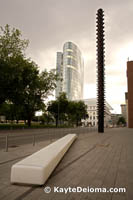 Dusseldorf is all about art and aesthetics. From its architecture and public art installations to its ten art museums and numerous galleries. You’ll see Kunst, the German word for art, everywhere. You’ll find the museum kunst palast (sic), Kunsthalle, Kunstverein, Kunstsammlung, Kunstacademie – palace, hall, association, collection and academy respectively – as well as the shortened K20 and K21 for 20th and 21st century art.
Dusseldorf is all about art and aesthetics. From its architecture and public art installations to its ten art museums and numerous galleries. You’ll see Kunst, the German word for art, everywhere. You’ll find the museum kunst palast (sic), Kunsthalle, Kunstverein, Kunstsammlung, Kunstacademie – palace, hall, association, collection and academy respectively – as well as the shortened K20 and K21 for 20th and 21st century art.
Obviously, if you only have a short period of time, you can’t see everything. You can choose your art museums based on your interests – the museum kunst palast for art from the Middle Ages through the present, K20 for 20th century art, K21 for 21st century art, the Hetjens for ceramics, or the Kunsthalle for changing contemporary exhibits, for example. Or you can do what I did and make a decision based purely on geography.
K20 Collection of North Rhine Westphalia
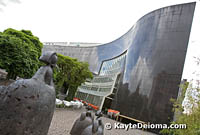 I started at Grabbeplatz, a square just north of Old Town flanked by the elegantly curved black façade of the K20 Versammlung Nordrhein-Westfalen (North Rhine Westphalia Collection) to the north and the Kunsthalle and Kunstverein sharing a utilitarian building to the south.
I started at Grabbeplatz, a square just north of Old Town flanked by the elegantly curved black façade of the K20 Versammlung Nordrhein-Westfalen (North Rhine Westphalia Collection) to the north and the Kunsthalle and Kunstverein sharing a utilitarian building to the south.
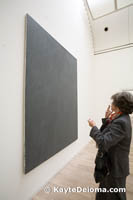 The K20 collection was built around an initial acquisition of around 100 paintings and drawing s by Paul Klee, which is displayed in three dedicated galleries. There are also two rooms devoted to Chinese-influenced German artist Julius Bissier and another two dominated by Gerhard Richter, one of the few living artists whose work is on display in K20.
The K20 collection was built around an initial acquisition of around 100 paintings and drawing s by Paul Klee, which is displayed in three dedicated galleries. There are also two rooms devoted to Chinese-influenced German artist Julius Bissier and another two dominated by Gerhard Richter, one of the few living artists whose work is on display in K20.
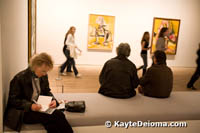 Not so numerous, but equally impressive, are the works of other 20th century artists including Picasso, Dali, Matisse, Magritte, Chagall, Kandinsky, Ernst, Beckman, Pollack and Warhol. There is also a significant amount of space devoted to temporary exhibits. The marvelous collection Picasso: Painting Against Time was having an extended run while I was there.
Not so numerous, but equally impressive, are the works of other 20th century artists including Picasso, Dali, Matisse, Magritte, Chagall, Kandinsky, Ernst, Beckman, Pollack and Warhol. There is also a significant amount of space devoted to temporary exhibits. The marvelous collection Picasso: Painting Against Time was having an extended run while I was there.
To facilitate visitors being able to visit both K20 and K21, the Kunstsammlung Nordrhein Westfalen offers a combination ticket and a free loan of aMuseums Bike to ride across town from one to the other. You can check out a bike key at either museum with ID and a refundable deposit.
Kunsthalle and Kunstverein
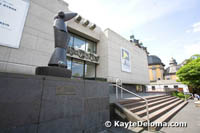 Across the square both the Kunsthalle and Kunstverein offer rotating exhibits of work by contemporary artists. It’s a large, well-lit space, but there were disappointingly few pieces in the Kunsthalle exhibit. A couple of them were interesting, but most forgettable. The best thing I can say about the work is that it was a temporary exhibit and will soon be replaced with something else.
Across the square both the Kunsthalle and Kunstverein offer rotating exhibits of work by contemporary artists. It’s a large, well-lit space, but there were disappointingly few pieces in the Kunsthalle exhibit. A couple of them were interesting, but most forgettable. The best thing I can say about the work is that it was a temporary exhibit and will soon be replaced with something else.
Across the hall the Kunstverein had devoted their entire space to an exhibit of photos and video by Irish artist Gerard Byrne, which was more interesting in concept than in execution.
Kunst im Tunnel
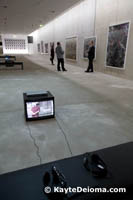 I had better luck when I stopped across town at the Kunsthalle’s other location, Kunst Im Tunnel (KIT), literally art in a tunnel at the foot of the Rheinknie Bridge. They’re open until 7 pm, an hour later than other museums, so I stopped there before going to a show at the Apollo Theater next door.
I had better luck when I stopped across town at the Kunsthalle’s other location, Kunst Im Tunnel (KIT), literally art in a tunnel at the foot of the Rheinknie Bridge. They’re open until 7 pm, an hour later than other museums, so I stopped there before going to a show at the Apollo Theater next door.
You enter the Tunnel through Café Curtiz im KIT , the glass-enclosed café set back from the Rhine, behind and above the Apollo. Look for the KIT painted on top of the building. Inside, a stairway will take you down into the irregularly shaped tunnel to see the current work on display.
The Kunst im Tunnel exhibit After Sputnik: New Pictures from the Dusseldorf Photography 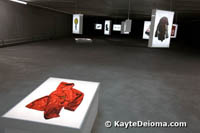 Scene, is a project of the 701 e.V. initiative, focusing on the work of young Dusseldorf artists. This particular collection of photographers were all students of Thomas Ruff (whose work you can see at K21) while he taught photography at the Kunstacademie Dusseldorf from 2000 to 2006.
Scene, is a project of the 701 e.V. initiative, focusing on the work of young Dusseldorf artists. This particular collection of photographers were all students of Thomas Ruff (whose work you can see at K21) while he taught photography at the Kunstacademie Dusseldorf from 2000 to 2006.
It’s a really interesting venue with a long curving space divided into a couple smaller galleries. In the first gallery, the floor slants up to meet the ceiling, and the walls converge 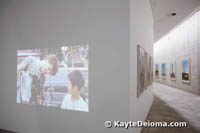 in a dark corner – an appropriate space to show off Lisa Nguyen’s Shipwrecked consisting of Durotrans light panels suspended from the ceiling and mounted on display tables.
in a dark corner – an appropriate space to show off Lisa Nguyen’s Shipwrecked consisting of Durotrans light panels suspended from the ceiling and mounted on display tables.
It’s much brighter in the larger galleries. The After Sputnik exhibit includes clever, thought-provoking photo series by photographers such as Robert Voit, Natalie Czech and Martina Sauter as well as an intriguing video installation by Juergen Staack and Sonja Rogusch. After Sputnik continues through July 15, 2007.
K21 Collection of North Rhine Westphalia
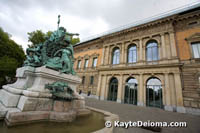 I didn’t have a chance to visit the K21 Collection of North Rhine Westphalia, but I did walk by the building after hours. The 21st Century art collection is located in the historicStändehaus, the original state parliament building, completed in 1880 and restored in 1947 after it was damaged in WWII. The Parliament moved to a new, modern building on the Rhine in 1988. The Ständehaus re-opened in 2002 as K21.
I didn’t have a chance to visit the K21 Collection of North Rhine Westphalia, but I did walk by the building after hours. The 21st Century art collection is located in the historicStändehaus, the original state parliament building, completed in 1880 and restored in 1947 after it was damaged in WWII. The Parliament moved to a new, modern building on the Rhine in 1988. The Ständehaus re-opened in 2002 as K21.
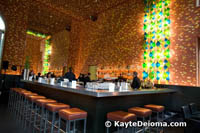 It’s an odd juxtaposition of the old and the new. Even on the outside of the building, quirky modern pieces have been strategically placed to hint at the buildings contents. A metal sculpture of a giant pistol is bolted to the cobblestones next to the 1897 bronze fountain of Father Rhine and His Daughters by Karl Janssen. A large baby-blue padlock hangs from a hook on the historic façade, and a bright yellow banana is painted near the front entrance. The swanky Bar am Kaiserteich at the back of the building stays open after the museum closes.
It’s an odd juxtaposition of the old and the new. Even on the outside of the building, quirky modern pieces have been strategically placed to hint at the buildings contents. A metal sculpture of a giant pistol is bolted to the cobblestones next to the 1897 bronze fountain of Father Rhine and His Daughters by Karl Janssen. A large baby-blue padlock hangs from a hook on the historic façade, and a bright yellow banana is painted near the front entrance. The swanky Bar am Kaiserteich at the back of the building stays open after the museum closes.
More Art
There are many other art institutions I didn’t get to see, including the Hetjens Ceramic Museum, the Art Academy and Dusseldorf’s oldest art museum, the museum kunst palast. Yet I came away with a clear sense of the city and state’s commitment to fine art, not just as a record of the past, but as a thriving expression of the Zeitgeist of today.
